Latin America Optical Imaging Market Size
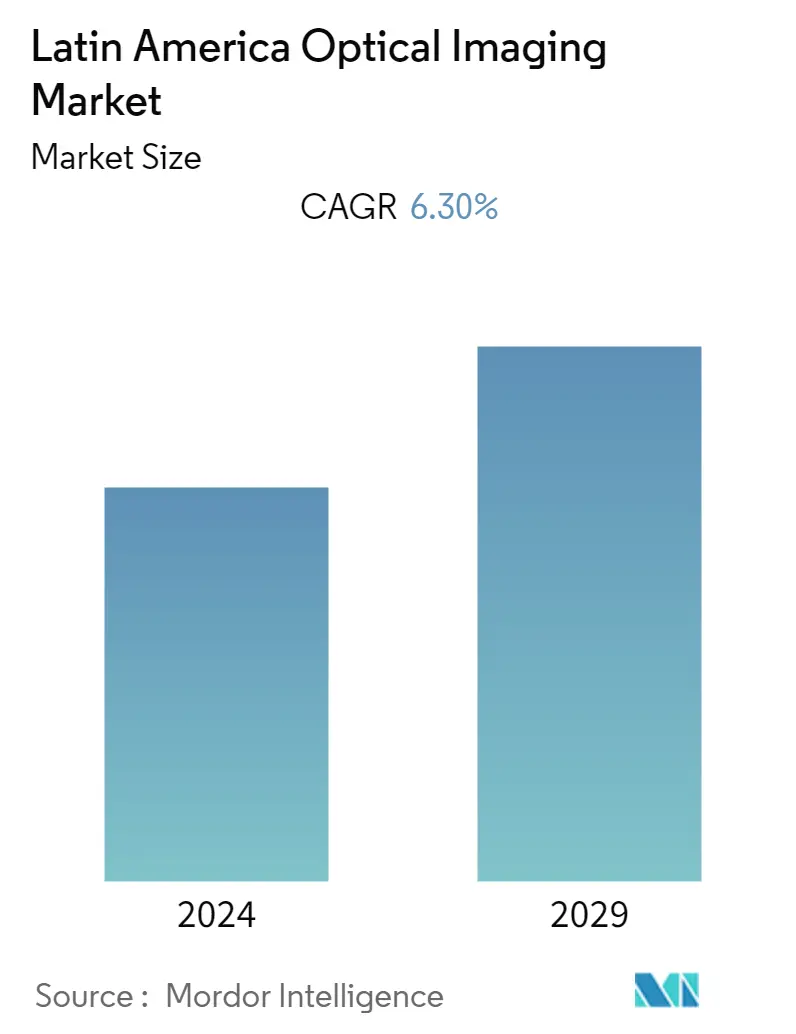
| Study Period | 2019 - 2029 |
| Base Year For Estimation | 2023 |
| Forecast Data Period | 2024 - 2029 |
| Historical Data Period | 2019 - 2022 |
| CAGR | 6.30 % |
| Market Concentration | Medium |
Major Players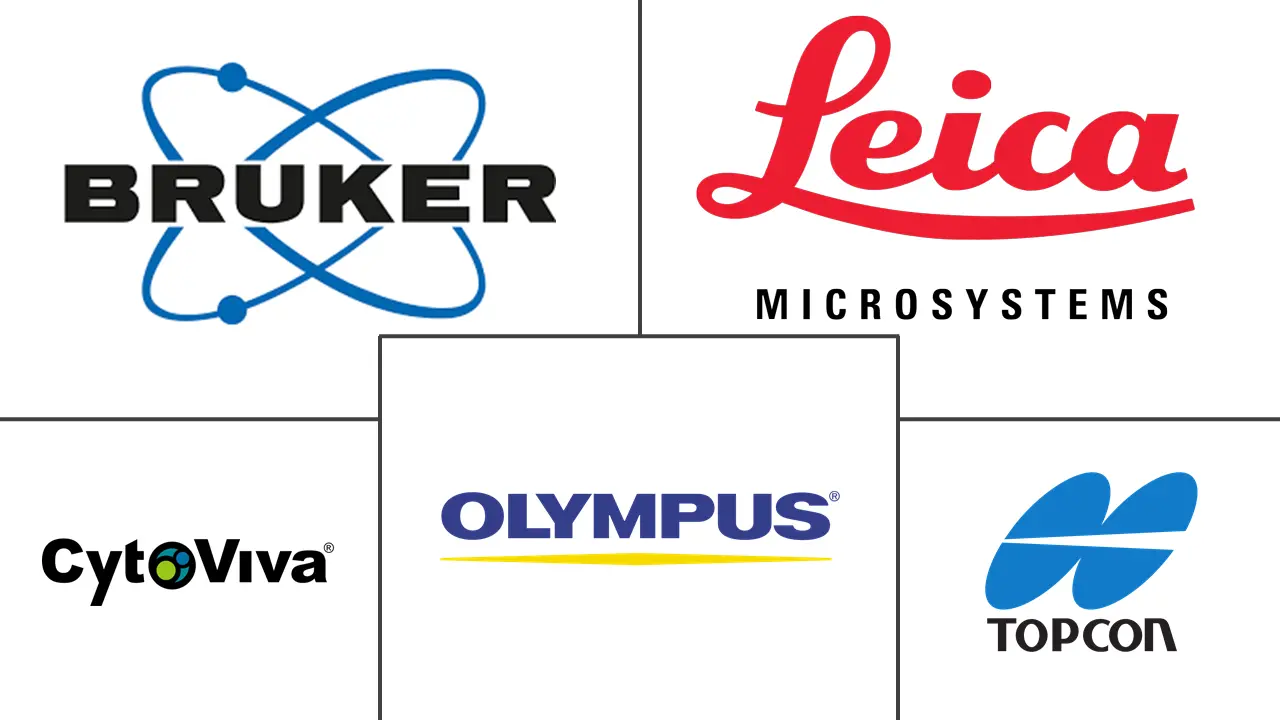
*Disclaimer: Major Players sorted in no particular order |
Latin America Optical Imaging Market Analysis
The Latin America Optical Imaging Market is expected to register a CAGR of 6.3% during the forecast period of 2022-2027. The rising prevalence of eye disorders, increased emphasis on medical device research and development, adoption of modern healthcare technologies, and a geriatric population contribute to the expansion of the optical imaging market in the region.
- Optical imaging allows the living brain to be examined closely, and many functional interactions and changes to be investigated over multiple length scales. The effects of treatments and pathologies can also be investigated using fairly basic optical imaging tools. Further, Optical imaging techniques have also revolutionized the investigation of cardiac cellular physiology and advanced the understanding of basic mechanisms of electrical activity, calcium homeostasis, and metabolism.
- Increased use of optical imaging modalities for diagnostic and therapeutic purposes such as disease diagnosis, preclinical research, and discrete molecular and cellular process imaging is expected to drive market growth in the region.
- According to IBGE, the national population of Brazil was composed in 1950 of 2.6 million seniors representing about 4.9% of the population. In 2020, the elderly population was already 30.1 million representing about 14.3% of the population. IBGE estimates show that by 2060, this group will grow at a rate of 3.6% per year compared to 0.2% of the population, reaching 73.4 million people by 2060, which will be equivalent to 32.2% of the population. The rising geriatric population of the region would aid the expansion of the studied market.
- However, the market's growth is hampered by high instrument costs, stringent regulatory approval procedures, a scarcity of qualified operators, and inadequate reimbursements for optical imaging operations.
- Further, due to COVID-19, several imaging and diagnostic departments have seen a rapid drop in optical imaging case volumes, owing to the increasing requirement for social distancing among patients, physicians, and other healthcare professionals.
Latin America Optical Imaging Market Trends
This section covers the major market trends shaping the Latin America Optical Imaging Market according to our research experts:
Hyperspectral Imaging is Estimated to Hold a Major Market Share
- Since the last twenty years, hyperspectral imaging(HSI) has witnessed the potential to become a key tool for research and identifying diseases in the healthcare field as it has a non-contact, non-ionizing, and label-free imaging modality.
- The utilization of HSI technology in the healthcare sector is likely to increase in the region. Moreover, the increasing number of investments in the sector is expected to propel the growth of this domain. The healthcare sector is undergoing a large-scale digital transformation, and these technologies are expected to have a major influence on the domain.
- Also, handheld Hyperspectral sensors are being rapidly implemented in healthcare operations for applications, such as rapid non-invasive assessment of healthy or diseased tissue in ambulatory surgery centers and wider use of miniaturized drones or UAVs for emergency rescue efforts, to name a few.
- Moreover, with the increase in the number of cancer patients, the need for cancer-treating equipment has increased. The International Agency for Research on Cancer 2021 reported Uruguay had the highest age-standardized cancer incidence rate among the Latin American countries studied in 2020, with 269.3 new cases per 100,000 people.
- Argentina and Brazil were next, with cancer incidence rates of 218.2 and 215.4, respectively. Meanwhile, in Guatemala, there were 123.1 new cancer cases per 100,000 persons. Lung cancer was the most deadly type of cancer in Argentina that year, inflicting 10.73 thousand fatalities in the country; such a high cancer incidence rate could increase the demand for hyperspectral imaging equipment.
- In Brazil, a drone-mounted hyperspectral camera by the vendor, Gamaya, aims to correlate spectral data with crop physiology to detect disease, weeds, and nutrient deficiencies. The company reported that it mapped around 30,000 hectares of farmland in Brazil.
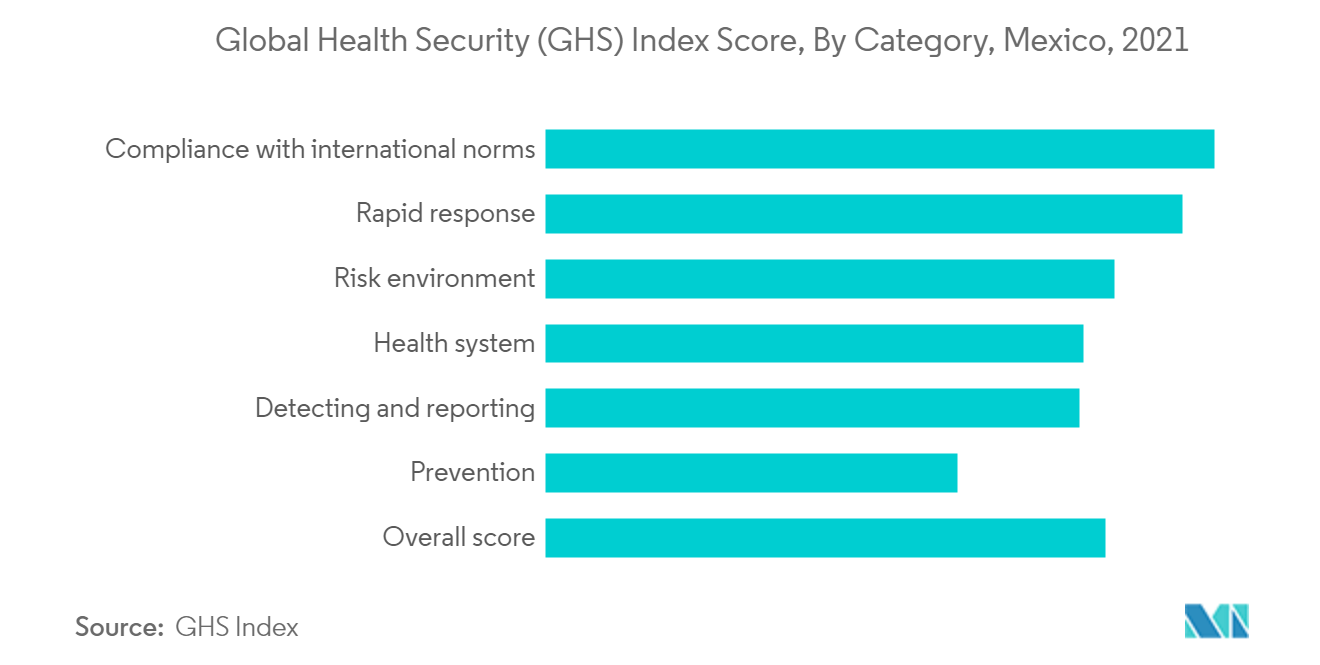
The Pharmaceutical Sector is Expected to Witness a Robust Growth
- Brazil is the primary recipient of foreign direct investment in Latin America, and it is emerging as a global manufacturing hub for pharmaceutical companies. According to government agency ANVISA (National Agency for Sanitary Control), the healthcare market of Brazil spends USD 158 million annually, with 54% accounted for in the private sector. The local private laboratories have the highest profit in the area, which depicts the increasing opportunity for Optical imaging to capitalize in the region.
- Due to favorable factors, such as low manufacturing costs and the presence of numerous Good Manufacturing Practice (GMP)-certified plants, the pharmaceutical companies are interested in entering the Brazilian market, thereby widening the scope of the contract manufacturing industry in the country. Due to lower investments in R&D within the pharmaceutical industry, Brazil is expected to have significant scope for the contract service providers over the forecast period.
- The local pharmaceutical manufacturing industry is quite dynamic; numerous initiatives related to biotechnological projects took place within this industry. The Brazilian government is attracting investments through support programs of the National Economic and Social Development Bank.
- The healthcare expenditure of the Mexica accounts for 5.5% of the GDP, according to OECD. The health insurance coverage for vulnerable populations expanded over time, accounting for 89.3% among the OECD countries. This has triggered the pharmaceutical companies to eye the Mexican market. However, due to weak support from the government and lower per capita health spending among the Mexican population, there is significant scope for outsourcing pharmaceutical manufacturing.
- Increasing chronic diseases, innovative biopharmaceuticals, medical devices, and assisted technologies, such as e-health and mHealth, are supportive of the pharmaceutical industry's future growth.
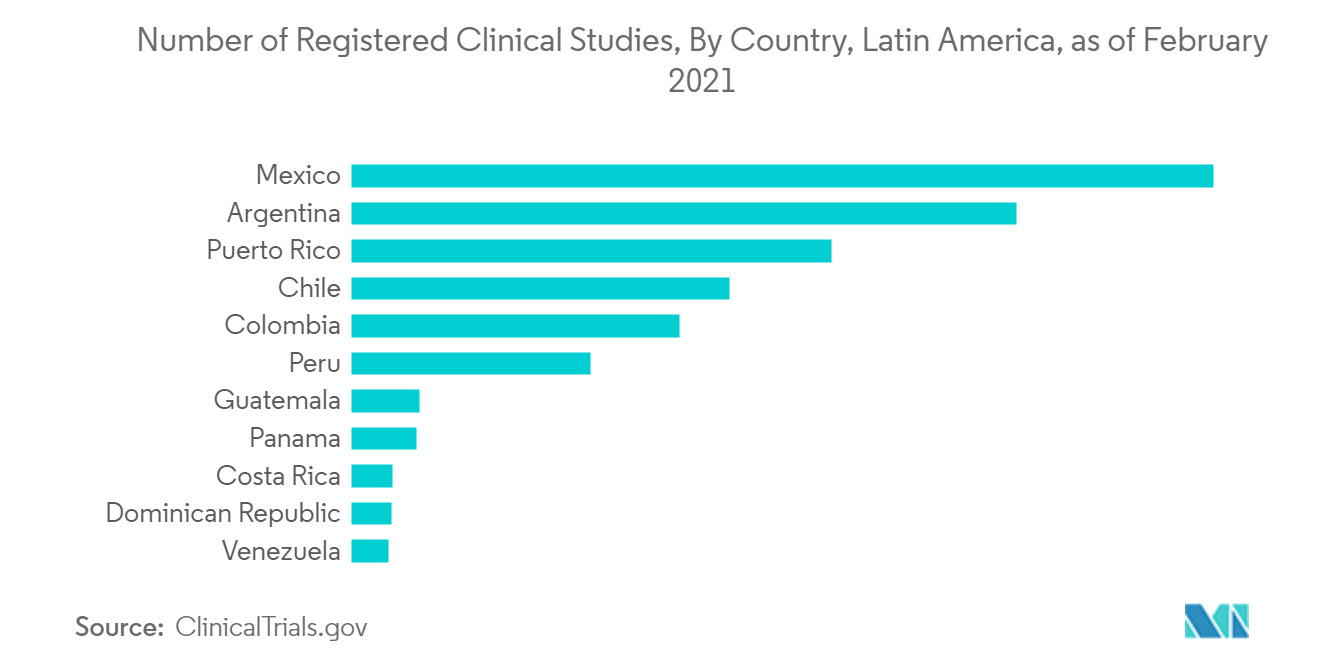
Latin America Optical Imaging Industry Overview
The Latin America Optical Imaging Market is moderately competitive with prominent players like Carl Zeiss Meditec AG, ASE Optics, Inc., Cytoviva Inc., etc. To maintain their position in the market, most of these players are constantly innovating and developing technologically advanced optical imaging devices and systems.
- July 2021 - Topcon Corporation acquired VISIA Imaging S.r.l, an ophthalmic device manufacturer, to strengthen its anterior segment device and software development and manufacturing capabilities, complementing its robust portfolio of fundus imaging technologies, including fundus cameras and optical coherence tomography (OCT).
- January 2021 - Leica Microsystems announced a partnership with Imperial College in the field of optical imaging and its use in research and innovation to set up a dedicated imaging hub, which will be equipped with advanced confocal and widefield microscopy systems.
Latin America Optical Imaging Market Leaders
-
Olympus Corporation
-
CytoViva, Inc.
-
Bruker Corporation
-
Leica Microsystems
-
Topcon Corporation
*Disclaimer: Major Players sorted in no particular order
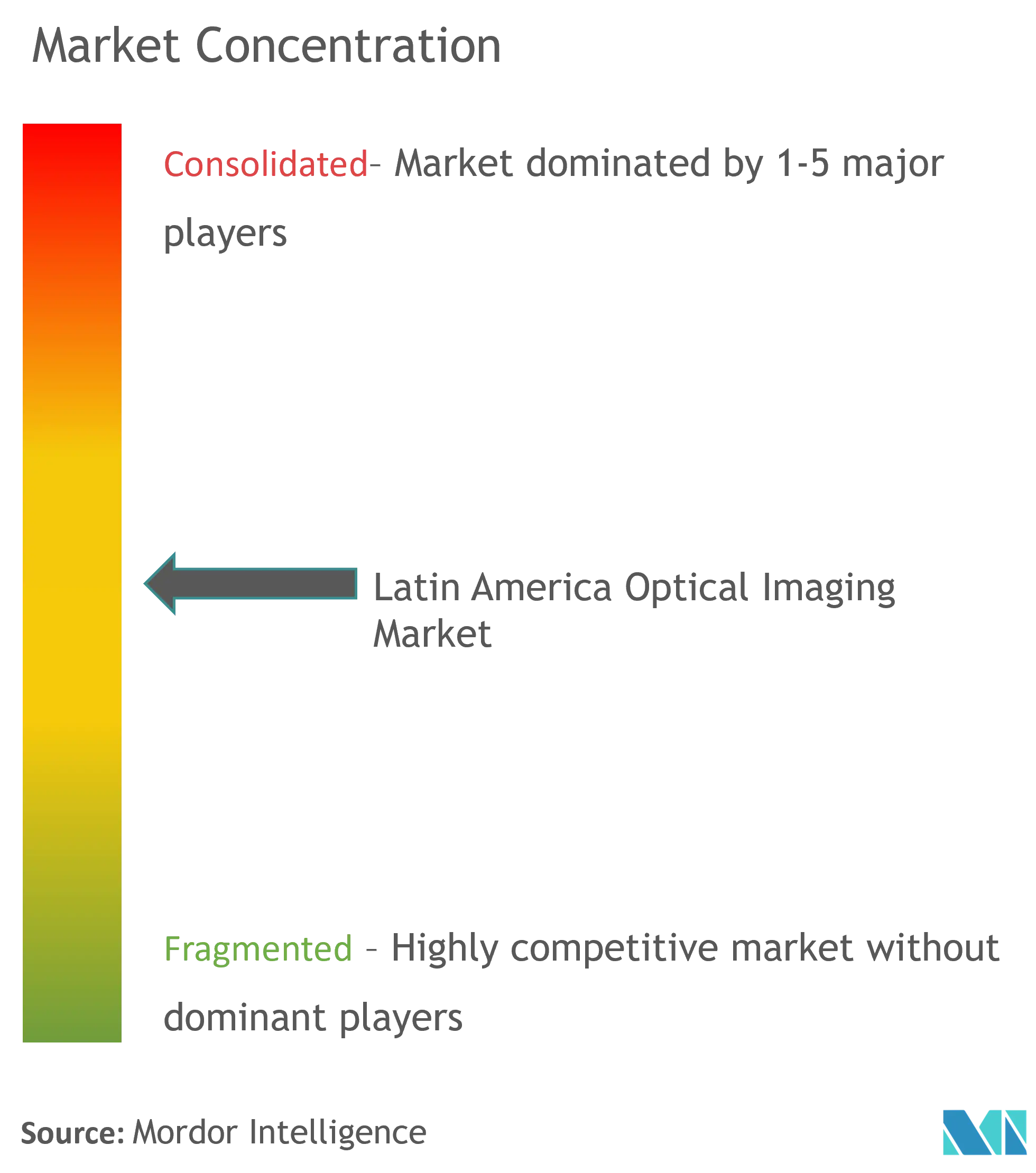
Latin America Optical Imaging Market News
- January 2022 - Bruker Corporation announced the release of the JPK NanoWizard V BioAFM, a very fast, automated BioAFM that can optionally be fully integrated with advanced optical microscopes. It enables rapid, quantitative mechanical measurements and the analysis of dynamics on samples ranging in size from sub-molecular to cells and tissues.
- February 2021 - Heidelberg Engineering Academy launched a CET Course Room, a free virtual platform that would enable optometrists and dispensing opticians to earn CET points through engaging with recorded webinars.
Latin America Optical Imaging Market Report - Table of Contents
1. INTRODUCTION
- 1.1 Study Assumptions and Market Definition
- 1.2 Scope of the Study
2. RESEARCH METHODOLOGY
3. EXECUTIVE SUMMARY
4. MARKET INSIGHT
- 4.1 Market Overview
- 4.2 Industry Value Chain Analysis
-
4.3 Industry Attractiveness - Porter's Five Forces Analysis
- 4.3.1 Bargaining Power of Suppliers
- 4.3.2 Bargaining Power of Buyers
- 4.3.3 Threat of New Entrants
- 4.3.4 Threat of Substitute Products
- 4.3.5 Intensity of Competitive Rivalry
- 4.4 Technology Snapshot
- 4.5 Assessment of the Impact of COVID-19 on the Industry
5. MARKET DYNAMICS
-
5.1 Market Drivers
- 5.1.1 Rising Demand for Ophthalmology
- 5.1.2 Advancements in Technology
-
5.2 Market Restraints
- 5.2.1 High Initial Cost of the Equipment
6. MARKET SEGMENTATION
-
6.1 Technology
- 6.1.1 Photoacoustic Tomography
- 6.1.2 Optical Coherence Tomography
- 6.1.3 Hyperspectral Imaging
- 6.1.4 Near-Infrared Spectroscopy
-
6.2 Product
- 6.2.1 Imaging Systems
- 6.2.2 Illumination Systems
- 6.2.3 Lenses
- 6.2.4 Optical Imaging Software
- 6.2.5 Others
-
6.3 Application Areas
- 6.3.1 Ophthalmology
- 6.3.2 Oncology
- 6.3.3 Cardiology
- 6.3.4 Dermatology
- 6.3.5 Neurology
- 6.3.6 Dentistry
- 6.3.7 Others
-
6.4 End-User Industry
- 6.4.1 Hospitals and Clinics
- 6.4.2 Research and Diagnostic Laboratories
- 6.4.3 Pharmaceutical Industry
- 6.4.4 Biotechnology Companies
-
6.5 Country
- 6.5.1 Brazil
- 6.5.2 Mexico
- 6.5.3 Colombia
- 6.5.4 Argentina
- 6.5.5 Rest of Latin America
7. COMPETITIVE LANDSCAPE
-
7.1 Company Profiles
- 7.1.1 Bruker Corporation
- 7.1.2 Carl Zeiss AG
- 7.1.3 Leica Microsystems
- 7.1.4 CytoViva, Inc.
- 7.1.5 Abbott laboratories
- 7.1.6 Topcon Corporation
- 7.1.7 Headwall Photonics Inc.
- 7.1.8 Perkinelmer Inc.
- 7.1.9 Agfa-Gevaert NV
- 7.1.10 Heidelberg Engineering
- 7.1.11 Olympus Corporation
- *List Not Exhaustive
8. INVESTMENT ANALYSIS
9. FUTURE OUTLOOK
** Subject To AvailablityLatin America Optical Imaging Industry Segmentation
The Latin America Optical Imaging Market is Segmented by Technology (Photoacoustic Tomography, Optical Coherence Tomography, Hyperspectral Imaging, Near-Infrared Spectroscopy), Product (Imaging Systems, Illumination Systems, Lenses, Optical Imaging Software), Application Areas (Ophthalmology, Oncology, Cardiology, Dermatology, Neurology, Dentistry), End-User Industry (Hospitals and Clinics, Research and Diagnostic Laboratories, Pharmaceutical Industry, Biotechnology Companies), and Country.
Optical imaging is a technique that utilizes light and photon properties to develop detailed images of organs, tissues, cells, and even molecules. The procedure offers non-invasive or slightly invasive ways to view within the body.
| Technology | Photoacoustic Tomography |
| Optical Coherence Tomography | |
| Hyperspectral Imaging | |
| Near-Infrared Spectroscopy | |
| Product | Imaging Systems |
| Illumination Systems | |
| Lenses | |
| Optical Imaging Software | |
| Others | |
| Application Areas | Ophthalmology |
| Oncology | |
| Cardiology | |
| Dermatology | |
| Neurology | |
| Dentistry | |
| Others | |
| End-User Industry | Hospitals and Clinics |
| Research and Diagnostic Laboratories | |
| Pharmaceutical Industry | |
| Biotechnology Companies | |
| Country | Brazil |
| Mexico | |
| Colombia | |
| Argentina | |
| Rest of Latin America |
Latin America Optical Imaging Market Research FAQs
What is the current Latin America Optical Imaging Market size?
The Latin America Optical Imaging Market is projected to register a CAGR of 6.30% during the forecast period (2024-2029)
Who are the key players in Latin America Optical Imaging Market?
Olympus Corporation, CytoViva, Inc., Bruker Corporation, Leica Microsystems and Topcon Corporation are the major companies operating in the Latin America Optical Imaging Market.
What years does this Latin America Optical Imaging Market cover?
The report covers the Latin America Optical Imaging Market historical market size for years: 2019, 2020, 2021, 2022 and 2023. The report also forecasts the Latin America Optical Imaging Market size for years: 2024, 2025, 2026, 2027, 2028 and 2029.
Latin America Optical Imaging Industry Report
Statistics for the 2024 Latin America Optical Imaging market share, size and revenue growth rate, created by Mordor Intelligence™ Industry Reports. Latin America Optical Imaging analysis includes a market forecast outlook to 2029 and historical overview. Get a sample of this industry analysis as a free report PDF download.



